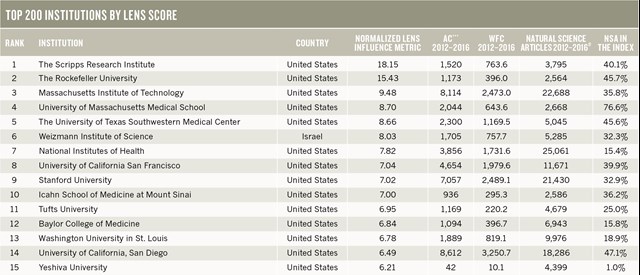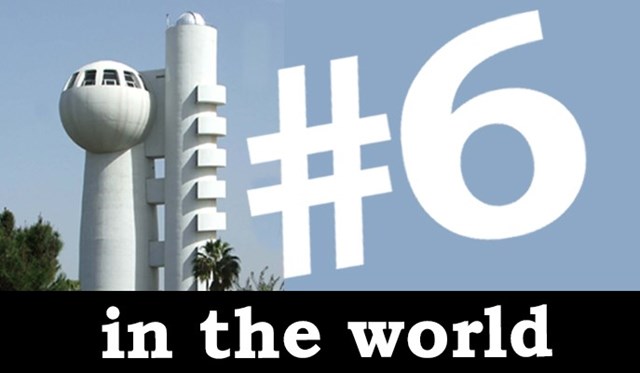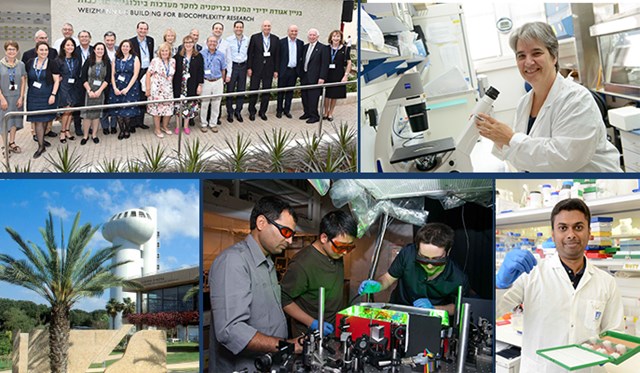The Weizmann Institute of Science: We recruit scientists who are among the best in the world and let them follow their curiosity
The Nature Index of Innovation 2017 points industry to institutions providing ideas behind inventions
REHOVOT, ISRAEL—August 9, 2017—The Nature Index of Innovation, published August 9, 2017, places the Weizmann Institute of Science in sixth place in an international ranking of the world’s top 200 research institutions. To determine placements, the Nature Index – affiliated with renowned scientific journal Nature – examined how research articles are cited in third-party patents, then ranked the institutions according to the impact produced by their academic research.
The rationale for this process is that by looking at patents owned by third parties – informed by and citing academic work – rather than those held by institutions themselves, the influence of research on the development of products and services is exposed.
According to Nature, the academic players featured in the index are those “whose ideas may shape tomorrow’s inventions. The top of these tables are occupied by both institutions with global reputations for high-quality research and others whose published work is having a disproportionately high impact relative to their size.”
The Weizmann Institute of Science in Israel is the only non-U.S. institution in the top 10. It follows such heavyweights as The Scripps Research Institute in San Diego, Rockefeller University in New York City, and the Massachusetts Institute of Technology in Boston.
David Swinbanks, founder of the Nature Index, said: “This analysis comes at a time when following the transfer of scientific knowledge into industry and the economy is a growing priority for governments and research-funding agencies – for them, the need to demonstrate that publicly funded science is being used for society’s benefit is paramount.”
Prof. Daniel Zajfman, President of the Weizmann Institute of Science, said: “Our high place in this index reflects our guiding philosophy, which says that we recruit scientists who are among the best in the world and let them follow their curiosity. That is what leads, in the end, to innovative and surprising new applications that shape the future.” The Nature Index also revealed that the Weizmann Institute not only contributes to third-party patent applications, but ranks fifth in applications for patents of its own. This ranking is normalized to the breadth of the scientific activity of the Institute.

The Nature Index supplement is published by Nature, together with The Lens and Clarivate Analytics. These provided analytic tools to, in the words of Richard Jefferson, founder of The Lens, create “‘innovation cartography’ – rendering the complex process of science- and technology-enabled problem solving (STEPS) transparent. It will enable scientists, investors, businesses, and policy makers to make better, evidence-based choices of partnerships and pathways to deliver new products, services, and practices for society.”
This is the first time that the Nature Index data has been normalized against the total research output of an institution in the natural sciences, as indicated by the number of research articles an institution has published in Clarivate Analytics’ Web of Science. This provides a measure for comparing institutions’ output in the Nature Index relative to their research capacity, which can then be compared to the normalized figures.
About the Nature Index
First launched in November 2014, the Nature Index database tracks the author affiliations of research articles published in a group of 68 high-quality natural sciences journals that have been selected by an independent panel of active scientists.
About Nature Research
Nature Research is a portfolio of high-impact journals, products and services across the life, physical, chemical, and applied sciences – including journals, databases, and researcher services – dedicated to serving the scientific community.
Nature magazine, founded in 1869, is one of the world’s leading science journals. Nature Research also publishes a range of Nature-branded subscription journals; the leading open-access multidisciplinary journal Nature Communications; other open-access journals, including Scientific Reports; and a range of Nature Partner Journals that are produced in partnership with a range of prestigious institutions and societies. Together, these journals publish some of the world’s most significant scientific discoveries.
About the Lens
The Lens is a free, open, and secure global facility to make the innovation system more transparent, efficient, fair, and inclusive. The Lens is run by Lens.org, a U.S.-registered benefit corporation owned by founders Cambia (a global non-profit social enterprise) and QUT (Queensland University of Technology). The Lens is dedicated to “Solving the Problem of Problem SolvingTM.” In collaboration with global non-profit and public institutions, The Lens serves nearly all of the world’s patents as free and open digital public goods integrated and linked with scholarly and technical literature, along with regulatory, legal, and business data. The Lens creates applications to map the networks of influence of scholarship on enterprise (In4M and PatCite) and to understand biological sequence patenting (PatSeq). The Lens allows documents, collections, and analyses to be shared, annotated, and embedded to enable Innovation Cartography: the open mapping of the science and technology innovation ecosystem to broaden participation in equitable problem solving.
About Clarivate Analytics
Clarivate™ Analytics accelerates the pace of innovation by providing trusted insights and analytics to customers around the world, enabling them to discover, protect, and commercialize new ideas faster. Formerly the Intellectual Property and Science business of Thomson Reuters, Clarivate Analytics owns and operates a collection of leading subscription-based businesses focused on scientific and academic research, patent analytics and regulatory standards, pharmaceutical and biotech intelligence, trademark protection, domain brand protection, and intellectual property management. Clarivate™ Analytics is now an independent company with over 4,000 employees, operating in more than 100 countries, and which owns well-known brands that include Web of Science™, Cortellis™, Derwent, CompuMark™, MarkMonitor®, and Techstreet™, among others. For more information, visit clarivate.com.


